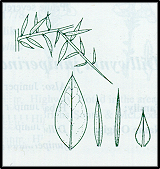South West Slopes Revegetation Guide
Santalum acuminatum
Quandong
Select from the following for detailed images.
Species Information
| Synonyms |
|
| Common Names |
Quandong, Sweet Quandong, Native Peach, Desert Quandong, Sandalwood |
| Family |
Santalaceae - Santalum family |
| Name Origin |
Santalum - from Greek santalon, the Sandalwood tree. acuminatum from Latin acuminatus, sharp or pointed, referring to leaves. |
Specimen Data -
| Location |
|
| Notes |
|
| Collector |
|
Date |
01/09/1997 |
| Determined By |
Unknown |
Date |
01/09/1997 |
South West Slopes Revegetation Guide Information
| Regional: |
Mainly west of the Olympic Highway. Noted in the areas: The Rock-Henty-Milbrulong; Boree; Brookong and Urangeline. Probably previously more widespread, but now confined to isolated patches. |
| Australia: |
Qld, NSW, SA, WA, NT. |
| Habitat: |
Various woodland communities, sandy sites to gravelly ridges. |
| Habit: |
Erect spindly shrub or small shapely tree to 6 m high. Spreading to drooping branches, and sparse pale to olive-green narrow leaves 3-9 cm long, in opposite pairs. |
| Similar Species: |
|
| Site Preference: |
|
| Characteristics: |
Parasitic on roots of other plants, at least when young. |
| Flowering: |
Whitish or cream, spring-summer or throughout year. |
| Seed Collection: |
Early Aug to late Nov. Monitor closely as seeds shed immediately or within 1-2 days of maturity. |
| Propagation: |
From seed. Before sowing, soak fruits in mild bleach solution for 30 minutes, then wash thoroughly in water. Sow fruits whole, or to hasten germination, gently crack or remove outer shells. Place nuts into sealed plastic bag with moist vermiculite and small amount of fungicide. Store at 16-250C. Seeds will germinate in 1-2 months. Carefully remove seeds when roots are about 1 cm long and place in large containers. Plant seedlings in 12 months with host plants, such as native grasses. Alternatively, plant seeds directly over host roots. |
| Regeneration: |
|
| Timber: |
Heartwood hard, close-grained, and flesh-coloured; sapwood creamy-pink. Emits pleasant fragrance when freshly cut. Works very well. Excellent for cabinet work, taking fine polish. |
| Shade and Shelter: |
|
| Land Protection: |
|
| Wildlife: |
|
| Ornamental: |
Attractive. |
| Other: |
European settlers favoured quandong fruit for pies, jellies, jams and dried fruit. Foliage has some fodder value. Wood used for making fire. Fruit useful food source. Scarlet acidic fruit pulp, rich in vitamin C was favoured, and sometimes a staple for short periods. Dried fruit from beneath trees soaked in water, or fashioned into cakes for storage. Oily kernels also eaten. Some trees produce sweet almond-flavoured kernels, while others produce distasteful ones. |
Note: The following information presented is only a guide, as plant characteristics vary depending on provenance (the plant's locality).
| Site/Preferred Habitat : |
sandy, gravelly sites, western areas |
| Rainfall(mm) : |
200-500 |
| Growth Rate : |
moderate |
| Tolerates : |
|
| Resents : |
|
| Uses & Comments : |
windbreak; wood turning; fodder; bush tucker; root parasite - requires host when young |
Return to Database List
